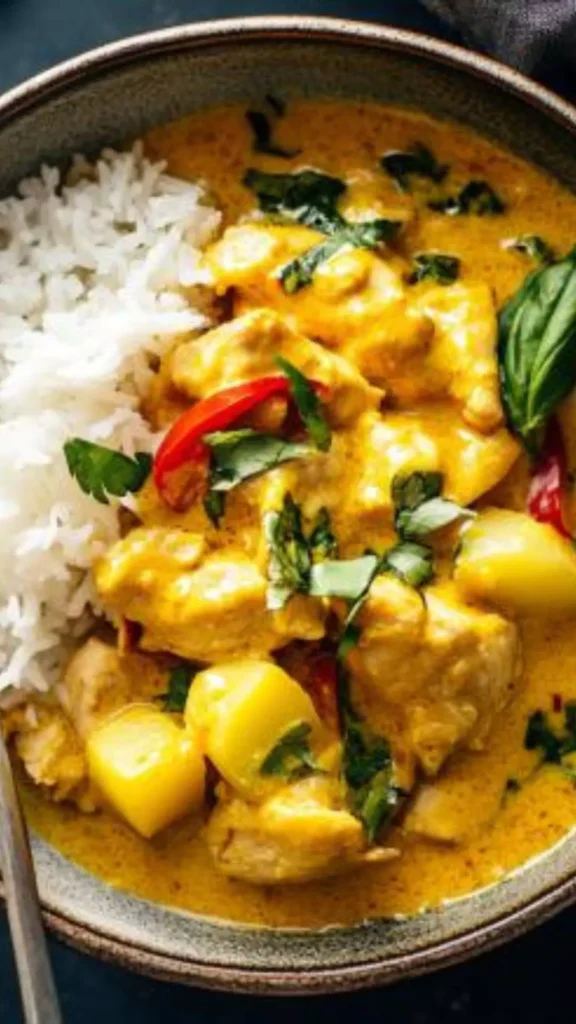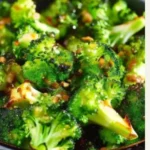Before diving into the rich, savory world of Thai yellow chicken curry with potatoes, let’s talk pairings. This dish’s deep flavors beg for some complementing sides. Consider serving it with jasmine rice, which beautifully absorbs the curry sauce. Fresh cucumber salad provides a refreshing crunch that balances the dish’s warmth. If you enjoy a touch of indulgence, naan bread or roti offers the perfect mop for the curry. Lastly, try a mango sticky rice for dessert — the sweet finish will round off your meal nicely.

Looking for a hearty, flavorful meal that’s a breeze to whip up? Well, let’s enter on a culinary journey to Thailand. Today, we’re diving into Thai yellow chicken curry with potatoes. This dish isn’t just a feast for the eyes with its golden hue; it’s a delightful blend of tender chicken, creamy potatoes, and a rich, aromatic curry sauce.
What is Thai Yellow Chicken Curry with Potatoes?
Thai yellow chicken curry with potatoes is a popular dish from Thailand that combines marinated chicken, potatoes, and a creamy coconut-based curry. The yellow curry paste, which typically includes ingredients like turmeric, coriander, cumin, and lemongrass, imparts a beautiful color and a fragrant aroma to the dish. The addition of coconut milk provides a creamy texture, making it incredibly comforting.
You will also like the following Dinner recipes!
- Best Four Cheese Pasta Cheesecake Factory
- How to make Cabbage goulash
- Easy Rainbow drive-in shoyu chicken
What Does It Taste Like?
Oh, the taste. Think of the mouth-watering flavors: the creaminess of coconut milk, the earthiness of turmeric, and the gentle heat from the curry paste. The chicken is tender, and the potatoes have absorbed the rich curry sauce. Each bite introduces a new layer of flavor, from the warmth of the ginger to the brightness of the lime juice. It’s a harmonious blend of sweet, savory, and spicy.
Why Does This Recipe Work?
Here’s why this recipe is a keeper:
Easy to Prepare: Minimal chopping and prepping required. Perfect for busy weeknights.
Comfort Food: The creamy texture and rich flavors make it the ultimate comfort food.
Adaptable: You can easily swap ingredients based on what you have available.
Nutrient-Rich: Packed with protein from the chicken, healthy fats from coconut milk, and nutrients from the potatoes and spices.
Ingredients For Thai Yellow Chicken Curry with Potatoes
Before we get cooking, gather these ingredients:
- 1 tablespoon avocado oil
- 1 pound boneless, skinless chicken breasts, cut into bite-sized chunks
- Half a yellow onion, finely sliced
- 1 tablespoon finely grated ginger
- 10 baby golden Yukon potatoes, halved or cut into bite-sized pieces
- 1/4 cup yellow curry paste
- 1 can (14 ounces) unsweetened coconut cream or coconut milk
- 1/2 – 1 cup water or chicken broth
- A generous pinch of sea salt
- 2 teaspoons fish sauce (optional)
- 1 tablespoon palm sugar or brown sugar (optional)
- 1 tablespoon lime juice
- For Serving: 1/4 cup fresh cilantro, chopped, and 2 cups uncooked jasmine rice

Step by Step Instructions
Step 1: Prepare Ingredients
Start by gathering all your ingredients. Chop the chicken and veggies before you start cooking. This ensures you can focus entirely on the cooking process.
Step 2: Cook the Chicken
Warm up a large skillet or pot over medium-high heat. Add the avocado oil. Once hot, toss in the chicken chunks. Cook until they are no longer pink, about 5-7 minutes. Remove them from the skillet and set aside.
Step 3: Sauté Aromatics
In the same skillet, add the sliced onions and grated ginger. Sauté for about 2-3 minutes until fragrant. This step is crucial as it builds the base flavor for your curry.
Step 4: Add Curry Paste and Potatoes
Add the yellow curry paste to the skillet. Sauté for another 2 minutes. Then, toss in the halved baby potatoes. Stir well to coat them in the curry paste.
Step 5: Add Liquids and Simmer
Pour in the coconut milk (or coconut cream, if you prefer a richer texture) and 1/2 cup of water or chicken broth. Stir everything together. Bring the mixture to a gentle boil, then reduce heat and let it simmer uncovered for about 20 minutes. This ensures the potatoes cook through and absorb the curry flavors.
Step 6: Season
Add the cooked chicken back into the skillet. Stir in the sea salt, fish sauce, palm sugar, and lime juice. Let it simmer for another 5 minutes to allow the flavors to meld together.
Step 7: Serve
Serve hot over jasmine rice. Garnish with fresh cilantro for a pop of color and additional flavor.
Notes
- Choose the Right Potatoes: Baby Yukon potatoes work best as they hold their shape well.
- Thin or Thick Curry: Adjust the consistency of your curry by adding more or less broth or water.
- Sweetness Level: Adjust the sweetness by adding more or less palm or brown sugar.
- Coconut Cream vs. Milk: Use coconut cream for a thicker, richer curry or coconut milk for a lighter version.
- Spice Level: Fine-tune the heat by adjusting the amount of curry paste or adding fresh chilies.

Nutrition Information
How To Store The Leftovers?
Made too much? No problem!
- Fridge: Store in an airtight container for up to 4 days.
- Freezer: Place in a freezer-safe container and freeze for up to 3 months. Thaw overnight in the refrigerator before reheating.
- Reheat: Warm up gently on the stove, adding a splash of water or broth to loosen the sauce if it thickened too much.
Sides For Thai Yellow Chicken Curry with Potatoes
Let’s elevate the meal with some side dishes:
Steamed Jasmine or Basmati Rice: Rice is a classic pairing as it absorbs the rich curry sauce perfectly.
Cucumber Salad: Fresh and crunchy, cucumber salad with a light vinaigrette provides a contrasting freshness.
Naan Bread: A soft, buttery naan is perfect for scooping up every last drop of the curry.
Roasted Vegetables: A mix of roasted bell peppers, carrots, and zucchini adds a nutritional boost and a great texture contrast.
Alternative Choices for Ingredients
Running low on ingredients? No problem! Here are some swaps:
Chicken: Try tofu or chickpeas for a vegetarian twist. They absorb the curry flavors wonderfully.
Potatoes: Sweet potatoes or carrots make fantastic alternatives, adding a touch of sweetness.
Avocado Oil: Use olive oil or coconut oil instead. Both work well and add distinct flavors.
Fish Sauce: Soy sauce or tamari (for a gluten-free option) are great substitutes for that umami flavor.

Thai yellow chicken curry with potatoes
Equipment
- large skillet
Ingredients
- 1 tablespoon avocado oil
- 1 pound boneless skinless chicken breasts, cut into bite-sized chunks
Half a yellow onion, finely sliced
- 1 tablespoon finely grated ginger for added warmth and depth
- 10 baby golden Yukon potatoes halved or cut into bite-sized pieces
- 1/4 cup yellow curry paste
- 1 can 14 ounces of unsweetened coconut cream or coconut milk (refer to notes)
- 1/2 – 1 cup water or chicken broth
A generous pinch of sea salt
- 2 teaspoons fish sauce optional, for a deeper umami flavor
- 1 tablespoon palm sugar or brown sugar optional, for a hint of sweetness
- 1 tablespoon lime juice to brighten and balance the flavors
For Serving:
- 1/4 cup fresh cilantro chopped
- 2 cups uncooked jasmine rice
Instructions
Step 1: Prepare Ingredients
- Start by gathering all your ingredients. Chop the chicken and veggies before you start cooking. This ensures you can focus entirely on the cooking process.
Step 2: Cook the Chicken
- Warm up a large skillet or pot over medium-high heat. Add the avocado oil. Once hot, toss in the chicken chunks. Cook until they are no longer pink, about 5-7 minutes. Remove them from the skillet and set aside.
Step 3: Sauté Aromatics
- In the same skillet, add the sliced onions and grated ginger. Sauté for about 2-3 minutes until fragrant. This step is crucial as it builds the base flavor for your curry.
Step 4: Add Curry Paste and Potatoes
- Add the yellow curry paste to the skillet. Sauté for another 2 minutes. Then, toss in the halved baby potatoes. Stir well to coat them in the curry paste.
Step 5: Add Liquids and Simmer
- Pour in the coconut milk (or coconut cream, if you prefer a richer texture) and 1/2 cup of water or chicken broth. Stir everything together. Bring the mixture to a gentle boil, then reduce heat and let it simmer uncovered for about 20 minutes. This ensures the potatoes cook through and absorb the curry flavors.
Step 6: Season
- Add the cooked chicken back into the skillet. Stir in the sea salt, fish sauce, palm sugar, and lime juice. Let it simmer for another 5 minutes to allow the flavors to meld together.
Step 7: Serve
- Serve hot over jasmine rice. Garnish with fresh cilantro for a pop of color and additional flavor.
Notes
- Choose the Right Potatoes: Baby Yukon potatoes work best as they hold their shape well.
- Thin or Thick Curry: Adjust the consistency of your curry by adding more or less broth or water.
- Sweetness Level: Adjust the sweetness by adding more or less palm or brown sugar.
- Coconut Cream vs. Milk: Use coconut cream for a thicker, richer curry or coconut milk for a lighter version.
- Spice Level: Fine-tune the heat by adjusting the amount of curry paste or adding fresh chilies.
Nutrition
FAQs
1. Can I make this curry in a slow cooker?
Absolutely! Simply add all the ingredients to your slow cooker, except the lime juice and cilantro. Cook on low for 6-7 hours or on high for 3-4 hours. Stir in the lime juice and cilantro just before serving.
2. Is this curry spicy?
The level of spice can vary. Yellow curry is generally milder compared to red or green curries. However, you can adjust the heat level by adding more or less curry paste or including fresh chilies.
3. Can I use canned potatoes?
While fresh potatoes are preferred for their texture, canned potatoes can be a quick substitute in a pinch. Just be aware that they may break down faster during cooking.
4. How can I make this dish gluten-free?
This dish is naturally gluten-free if you use a gluten-free fish sauce or soy sauce. Always check labels to ensure your curry paste doesn’t contain any hidden gluten.
Conclusion
Thai yellow chicken curry with potatoes is not just a meal; it’s an experience. Rich, flavorful, and deeply comforting, it’s perfect for any occasion. Whether you’re looking to impress guests or simply enjoy a cozy night in, this dish has got you covered. So, gather your ingredients, follow the steps, and get ready to savor a bowl of deliciousness. Bon appétit!
Hopefully, you enjoy making and eating this as much as I do. Until next time, happy cooking!
You’ll also like these latest recipes!
- Best Chiavetta’s Chicken Recipe
- How to make Asian coconut chicken
- Easy Bonchon soy garlic chicken wings recipe
Hi! I'm Mary Lee. I love helping people eat yummy and healthy food. I live in Oregon. Cooking is my happy place. Let's make tasty dishes together!




